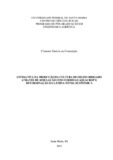| dc.creator | Conceição, Chaiane Guerra da | |
| dc.date.accessioned | 2021-12-06T16:57:57Z | |
| dc.date.available | 2021-12-06T16:57:57Z | |
| dc.date.issued | 2021-01-04 | |
| dc.identifier.uri | http://repositorio.ufsm.br/handle/1/23169 | |
| dc.description.abstract | One of the technologies that has been used notably in agriculture is the simulation of crop growth and productivity, as well as obtaining parameters that respond to the efficient use of irrigation water, reducing the volume of water used. Thus, the objective of this study was to evaluate the performance of the AquaCrop model for different hybrids of irrigated corn under different levels, in different edaphoclimatic scenarios, as well as to determine the optimal economic level for the region of Alegrete, RS. Data from experiments of four harvests were used: 2015/16 and 2016/17 harvests, developed in the municipality of Santiago, RS, and conducted by Ben (2019), in a randomized block design, composed of five irrigation treatments (0 , 50, 75, 100 and 125% of ETc), with four and six corn cultivars, respectively, and four replicates each; and 2017/18 and 2018/19 crops, developed in the municipality of Alegrete, RS, in a randomized block design, composed of five irrigation treatments (0, 50, 75, 100 and 125% of ETc) (2017/18 harvest) ), and 0%; 50, 75 and 100% (suppressed by 50% in the reproductive period of the culture); and, 100% of the ETc (2018/19 harvest), with three repetitions each. The hybrids used to calibrate the model were: AG 9025 (Santiago - 2015/16) and AG 8780 (Alegrete - 2017/18), while for validation were used: AG 9045, DKB 240 and Status VIP3 (2015/16 crop); AG 9025, AG 8780, DKB 177, DKB 230, DKB 290 and P1630H (2016/17 harvest); and AG 8780 (2018/19 harvest). The main results of this study demonstrated satisfactory performance of the AquaCrop model, obtaining ratings from “good” to “excellent”. Even if the model tends to overestimate or underestimate the results, in some conditions, it can be used, given its adaptability to different corn hybrids and water conditions. Corn production responds positively to supplementary irrigation in the region of Alegrete, RS, for the cultivar AG 8780, suggesting that levels greater than 81.5% of ETc should not be used, aiming at the greatest economic return. | eng |
| dc.language | por | por |
| dc.publisher | Universidade Federal de Santa Maria | por |
| dc.rights | Attribution-NonCommercial-NoDerivatives 4.0 International | * |
| dc.rights.uri | http://creativecommons.org/licenses/by-nc-nd/4.0/ | * |
| dc.subject | Modelagem | por |
| dc.subject | Zea mays L. | por |
| dc.subject | Irrigação | por |
| dc.subject | Déficit hídrico | por |
| dc.subject | Híbridos | por |
| dc.subject | Modeling | eng |
| dc.subject | Irrigation | eng |
| dc.subject | Water déficit | eng |
| dc.subject | Hybrids | eng |
| dc.title | Estimativa da produção da cultura do milho irrigado através de simulação com o modelo AquaCrop e determinação da lâmina ótima econômica | por |
| dc.title.alternative | Estimated production of irrigated maize culture by simulation with the AquaCrop model and determination of the economic optimum level | eng |
| dc.type | Tese | por |
| dc.description.resumo | Uma das tecnologias que vem sendo notadamente utilizada na agricultura é a simulação de crescimento e produtividade das culturas, assim como obter parâmetros que respondam ao uso eficiente da água da irrigação, diminuindo o volume de água utilizada. Assim, o objetivo deste estudo foi avaliar o desempenho do modelo AquaCrop para diferentes híbridos de milho irrigado sob diferentes lâminas, em diferentes cenários edafoclimáticos, bem como, determinar a lâmina ótima econômica, para a região de Alegrete, RS. Foram utilizados dados de experimentos de quatro safras sendo: safras 2015/16 e 2016/17, desnolvidos no município de Santiago, RS, e conduzidos por Ben (2019), em delineamento de blocos ao acaso, compostos por cinco tratamentos de irrigação (0, 50, 75, 100 e 125% da ETc), com quatro e seis cultivares de milho, respectivamente, e quatro repetições cada; e safras 2017/18 e 2018/19, desenvolvidos no município de Alegrete, RS, em delineamento de blocos ao acaso, compostos por cinco tratamentos de irrigação (0, 50, 75, 100 e 125% da ETc) (safra 2017/18), e 0%; 50, 75 e 100% (suprimidos em 50% no período reprodutivo da cultura); e, 100% da ETc (safra 2018/19), com três repetições cada. Os híbridos utilizados na calibração do modelo foram: AG 9025 (Santiago - 2015/16) e AG 8780 (Alegrete – 2017/18), enquanto que para a validação foram utilizados: AG 9045, DKB 240 e Status VIP3 (safra 2015/16); AG 9025, AG 8780, DKB 177, DKB 230, DKB 290 e P1630H (safra 2016/17); e AG 8780 (safra 2018/19). Os principais resultados deste estudo demonstraram desempenho satisfatório do modelo AquaCrop, obtendo classificações de “bom” a “excelente”. Mesmo o modelo tendendo a superestimar ou subestimar os resultados, em algumas condições, o mesmo pode ser utilizado, visto sua adaptabilidade a diversos híbridos de milho e condições hídricas. A produção de milho responde positivamente à irrigação suplementar na região de Alegrete, RS, para a cultivar AG 8780, sugerindo que lâminas maiores de 81,5% da ETc não devem ser utilizadas, visando o maior retorno econômico. | por |
| dc.contributor.advisor1 | Robaina, Adroaldo Dias | |
| dc.contributor.advisor1Lattes | http://lattes.cnpq.br/8629241691140049 | por |
| dc.contributor.advisor-co1 | Peiter, Marcia Xavier | |
| dc.contributor.advisor-co1Lattes | http://lattes.cnpq.br/4072803412132476 | por |
| dc.contributor.referee1 | Gomes, Ana Carla dos Santos | |
| dc.contributor.referee2 | Parizi, Ana Rita Costenaro | |
| dc.contributor.referee3 | Fontanela, Eracilda | |
| dc.contributor.referee4 | Ben, Luis Humberto Bahú | |
| dc.creator.Lattes | http://lattes.cnpq.br/3837641596544485 | por |
| dc.publisher.country | Brasil | por |
| dc.publisher.department | Engenharia Agrícola | por |
| dc.publisher.initials | UFSM | por |
| dc.publisher.program | Programa de Pós-Graduação em Engenharia Agrícola | por |
| dc.subject.cnpq | CNPQ::CIENCIAS AGRARIAS::ENGENHARIA AGRICOLA | por |
| dc.publisher.unidade | Centro de Ciências Rurais | por |



